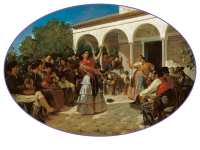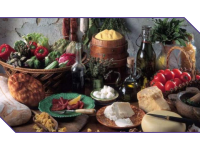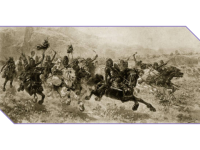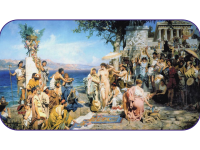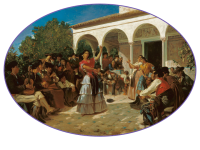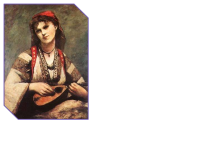With its proximity to the sea, and its roots running deep into the Old World, Adranyi culture is nothing short of the ultimate mixing pot of culture. It draws on many influences, be it through its cooking, festivities or language. The Adranyis could be broken down into many subcultures, each fiefdom or settlement having its own unique spin on what spices they may use or what clothing they may wear, yet Adranyis always consider themselves Adranyis first and above all else.
They are a strong willed, hot blooded, and passionate people, whose interests range from cultivation, literature, sciences, warfare and even the mystic arts.
It would not be incorrect to state that a majority of native Adranyis fall on the slightly darker side when it comes to their skin tone. Earthier skin tones ranging from a medium beige, to a Olive or golden tan are by far the norm, though some people do fall on either end of the spectrum. As more foreign cultures begin to assimilate into Adranyi culture, these outliers have become much more common. There is not much variance in hair either as most Adranyi have darker colored hair, most oftenly curly, wavy or straight that tends to be kept longer on average. The eye color of the Adranyi is predominantly brown and green with blue eyes being incredibly rare, and even seen as divine intervention in some subcultures.
The average Adranyi has a somewhat medium build, tending not to be overweight as most have physically demanding jobs and consume mostly healthy food. Strong jawlines, bow shaped lips and pointed noses accentuate an otherwise flat face. The average woman stands between 5’ and 5’3”, while the average man stands between 5’7” and 5’11”. Adranyi men have wide, round shoulders with a narrow waist and shorter necks. Adranyi women have wide, shapely hips with an otherwise narrow frame and long necks.
Due to the many variances in culture from region to region, it is hard to pinpoint a set in stone aesthetic for the Adranyi. Attire changes not only from region to region, but from social class to social class. Those living in more mountainous or forested areas may opt for longer dresses or skirts that flow in the wind, and provided some extra warmth in the colder seasons, while those from more coastal regions may wear lighter, sometimes almost see through clothes meant to keep them cool as they work the fields or train in the hot sun. In some regions the women chose to adorn themselves with shawls, scarves and other headwear, while some opt to let their hair fall naturally. Most Adranyi, regardless of gender, keep their hair longer with shorter hair being seen as the marking of the warrior class.
Regardless of the region, Adranyi have a knack for flair. They adorn themselves with bracelets, rings and necklaces made of, or adorned with, precious metals. Gold and silver are considered the norm when it comes to jewelry, but it is not uncommon to see jewelry made from ivory, antlers or other animal parts. Almost all Adranyi men wear a necklace adorned with a gold coin that has the marking of an anchor on one side and an eagle on the other, a gift from their fathers when they turn 13 and are welcomed as men into society.
Adranyi food is incredibly robust and sees no part of its raw ingredients wasted. The core elements of Adranyi food are grains, olive oil, vegetables and wine. Meats, primarily lamb, fish and beef, are incorporated into the dishes, but tend to not be the focal points. Spices such as garlic, onion, cumin, coriander, nutmeg, paprika, cloves and various ground up seeds truly amp up the flavor profile of Adranyi food, its robust and rich flavor making it stand out from other cuisines of the Old World.
Wine and dessert are a key piece of Adranyi cuisine, no meal being complete without several glasses of wine and a savory treat to end the meal on a sweet note. It is essentially a guarantee that any region within Adra has more wine options that one could ever need in a lifetime. Of all the fiefdoms within Adra, Raddusa is best known for its wide variety and high quality of wine options. Yet, no farm is complete without at least a small collection of grape vines to provide itself with a steady supply.
Puff pastries make up the core of Adranyi desserts, typically filled with some sort of fruit filling or a whipped, light cream filling sweetened with honey, both topped with crushed up nuts. If looking for a heavier dessert after a light meal it is also not uncommon for cakes to be made, the batter for which is made using a mixture of grain and ground up nuts as the base for a richer flavor.
There is no standing army that safeguards the lands belonging to Adra. Given its traditional policy of neutrality, it is uncommon for the King of Adra to mandate conscription in a kingdom-wide army. Instead, the duty falls upon the many Lords of Adra to ensure their own lands are properly guarded against common threats. Should the Kingdom as a whole come under a much larger threat, it is only then that the King would summon the Banners and garrisons of his lords. It is incredibly rare that an Adranyi lord would allow any under his banner, or even those that live in his lands, to act as mercenaries and fight in other people’s wars. It is considered culturally taboo to involve yourself in the business of other kingdoms and to shed the blood of those who have not wronged you in any capacity.
The Adranyi are most known for their impeccable skill with a recurved composite bow, be it on the ramparts of a castle or on the back of a horse. The steeds bred by the Ktinotrófos, or horse breeders, were famously claimed to be the fastest in the Old World. Though much doubt has been thrown on this claim due to the fact that the Adranyi hardly ever put armor or day packs on their horses, causing them to not be carrying nearly as much. While this may be true, it is still undeniable that the steeds bred in Adra are amongst the finest that money can buy.
Outside of their proficiency with bows they typically fight with spears and shields in a more organized army, though given that each Lord raises and equips his own army there can be variances. It is not uncommon for auxiliary units under a Banner to carry sabers, scimitars, shortswords, pikes or even maces into battle.
Apokries
Apokries is a sacred time for Adranyis, a 5 day long festival thrown in celebration and reverence of the All-Sun and his Demi-Gods. The first day of the festival has a much heavier focus on the religious side, with the Adranyi pilgrimaging to the nearest holy site to pay their respects and pray to the All-Sun and his saints. The second day of the feast is a day of feast, a time to recuperate after long journeys that may have started weeks prior to the actual start of the festival. Accompanying the second day of Apokries is an open door policy, all are welcome and considered friends. Windows and doors are left open, people coming and going from house to house, with many families opting to just move their table outside, filling the streets with laughter, music and light.
The activities of the third and fourth days vary upon the Leigelords wishes, though they typically revolve around the arts. This may take the form of a party in the bazaar, with various artists' works on display, or a beach party with colorful, beautiful kites flying high and dancing in the sun's rays. The fifth day is time for sports and games. While the activity itself may not be set in stone, the fifth day is a time for a display of physical prowess. This may take the form of a triathlon, a wrestling contest, or even a grand showing in a colosseum.
Weddings
Any Adranyi wedding is an event of enormous proportions. Known to last anywhere from one day to a whopping three days, it is more of a community event than just a family one. As Adranyi do not believe in arranged marriages, a wedding is a memory for the betrothed meant to last a lifetime. There is no inherent religious value to the wedding, as it is believed that a marriage is more of a social contract than a divine one, yet it is not uncommon for Adranyi to be married within a temple or some other religious site. Some believe this is simply due to the fact that most religious sites are inherently well-built and provide a beautiful backdrop, though this has never been outright proven.
The wedding ceremony itself is traditionally led by the bride's father, seen as a final blessing toward the union. However, should the bride's father have passed away, is off to war, or unable to attend for any other reason, the groom's father or any father figure to either the bride or the groom may stand in for the bride's father. The actual ceremony simply consists of the gifting of a plain, golden ring and the exchanging of vows. At the culmination of the exchanging of vows, each party shall say “Haverzh klini”, which loosely translates to common as ‘Forever it shall be’. It is customary for the groom, and only the groom, to repeat his vows thrice, a symbol of his devotion and a showing that the bride was not forced into the marriage.
The only thing left is to throw a party, which has been known to last several days should the weather stay fair and the married couple hold their drink and fight off the guaranteed hangover well enough. The party is a dance between the married couple and their community. The married couple will throw the party and festivities out of their own pocket, often relying on cash gifts to ensure their pockets do not stay empty and their marriage starts off on the right foot. That is not to say that non-money gifts are not allowed, simply not expected outside of people with immediate, personal connections to either the bride or groom.
Funerals
Despite the Adranyi’s proclivity toward parties and having a good time, funerals and the subsequent periods of mourning may by the exception to the rule. The Adranyi practice a custom called Shiva, a period of mourning lasting a full 7 days. The practice of Shiva only applies directly to the parents, children, spouse or siblings of the deceased, though community involvement is key for the family in mourning.
The first stage of Shiva takes place almost immediately upon learning of the death. It is during this time that the home of the deceased is prepared for the full 7 days of mourning. All mirrors in the home are covered, the living room is emptied of everything except chairs and a table in the center of the room, and the body of the deceased is prepared with some balms to keep it ‘fresh’ for 3 days before it is properly disposed of. Once prepared the body is placed upon the table in the living room and covered in a white sheet, the corners of which are held down with rocks that have been transcribed with various runes in reverence of the All-Sun.
During the full 7 day period it is expected that the family of the deceased will have nothing to want for, be it food, drink or rest. Visitors will bring the family food, and ensure that the living room of the house is kept tidy and free of garbage or anything non-essential for the mourning process. Visitors are expected to wash their hands and remove their shoes before entering the home. The first 3 days of this process are the most important and most taxing upon the family, the time in which outside help is expected the most. The family's sole responsibility is to pray for the beloved's safe passage to the Emerald Pools, where they may one day look upon their faces again.
The fourth day of Shiva is wholly devoted to the funeral and disposing of the body. On the night of the third day the men off the family shall leave the women to continue their prayer and head off to find enough wood for a large funeral pyre. They will work tirelessly through the night and most of the following day, ensuring they have enough fuel to keep the fire going throughout the next night. In the early evening of the fourth day, just before the sun sets, the body is removed from the living room and brought to the ceremony grounds that the male family members have prepared. Just as the sun sets behind the horizon, the pyre is lit and the deceased body and soul are sent to the All-Sun. The men of the family are expected to keep the fire going all through the night. Should the fire go out before the sun crests the horizon the following morning, the deceased soul is assumed to have been lost and cast into purgatory, never to be seen again.
Days 5, 6 and 7 are much the same as days 1-3, though the deceased’s presence on the table will have been replaced with candles and flowers and food brought to the family. It is not until sundown on the seventh day that the family will prepare a meal for themselves and put the house back to the way it was before, thus ending the period of Shiva.
Dialect
While all Adranyis speak common, a large majority also speak a bastardized version of Astellari, the Old Tongue of et’Atah, that sees a few key words and phrases changed for a more colloquial dialect. This dialect variant of Astellari is referred to as Rassik by most Adranyis, though it is 95% the same language in reality. Regardless of the dialect they are speaking, Adranyis are very keen on linguistic detail and perfection. They are verbose people, enjoying flowery and descriptive words that many would consider useless and a needlessly drawing out of a sentence. Adranyis forgo most contractions, more often than not saying ‘Cannot’ instead of ‘Can’t’, or ‘They Shall’ instead of ‘They’ll’.
This list of words that differentiates Rassik from Astellari is as follows:
Effendi - A gender neutral term that at its core simply means ‘friend’.
Mitír - Mother
Patír - Father
Adelfí - Sister
Adelfós - Brother
Baba - Grandmother
Papa - Grandfather
Doamne - Lord
Doamnă - Lady
Gitano - A term that literally translates to “Gypsy”. Incredibly offensive when used by a non-Adranyi.
Gadjo/Gadji - A term used by the Adranyi to indicate someone who is not native to Adra.
Bari - Hello
Antío - Goodbye
Shkran - Thank you
Călugări - Priest
Cagna - Derogatory term used to call someone a dog, or ‘less-than’.
Dracu - An exclamatory term meant to voice frustration or irritation, similarly to “Ah fuck!”, etc.
Proí - Morning
Nýchta - Night
Felicitari - Congratulations
Shumë - ‘Very’, often used in the same exclamatory context as “Excellent!” or “Extraordinary!”
Xotikó - Elf
Xotikó Skotádi - Dark Elf
Pitic - Dwarf
Sávra - Lizardmen
Darjic - Goblin
OOC: For the original, correctly formatted post please visit this Google doc: The History & Culture of The AdranyiThe Culture of the Adranyi With its proximity to the sea, and its roots running deep into the Old World, Adranyi culture is nothing short of the ultimate mixing pot of culture. It draws on many influences, be it through its cooking, festivities or language. The Adranyis could be broken down i...
Adra and the culture that it follows is meant to be a starting point for people looking to get into playing a human character with a unique culture that blends IRL ancient Greece, Romani, Jewish and ‘Asia Minor’ (Persia, Armenia, Turkey, etc.). The culture outlined above can be built upon, or used as a foundation for new cultures that chose to lean more in any direction. Players are free to create characters that come from ethnic Adra, the mainland that was taken over in the coup or the islands that still swear fealty to the disposed Crown and one day hope for revenge. I only ask that should you wish to create a house that has noble lineage that you first consult me (sykotic1867 on discord) so that I can ensure the backstory fits Adra and its current climate. |
Attachments
Last edited:
